UPDATE 16, APRIL 2019: A massive fire ravaged and destroyed large part of the Notre Dame Cathedral. The French President Emmanuel Macron has stated that he wanted the cathedral rebuilt in five years and made more beautiful than ever. However it is estimated that it can take years or even decades to rebuild the cathedral completely because of problems in sourcing the materials and painstakingly restoring the elements that have survived the fire.
The most well-known Gothic cathedral in France, Notre Dame is a Parisian landmark that’s a magnificent reminder of the architectural brilliance of the middle ages. The cathedral inspired the famous historical novel Notre Dame de Paris (1831) and then it was the success of this book that started a new wave of restorative work for the cathedral.
More than 12 million people visit Notre Dame annually and it’s the most visited monument of Paris. Covered with marvelous paintings, sculpture and stained glass bearing biblical references Notre Dame has weathered turbulence, riots and attacks and has still stood strong…French monarchs vied to be coronated inside its holy premises.
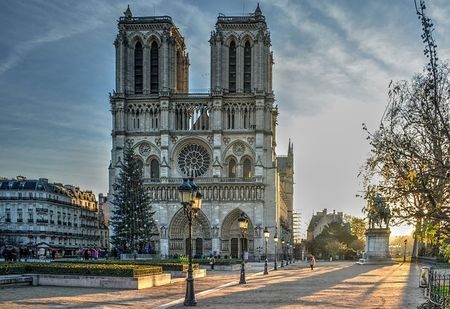
If you happen to visit the Notre Dame on a relatively uncrowded day you can see a 1924 dated circular marker with 8 clawed bronze star ensconced in the cobble path. Read the inscription “point zero des routes de France” meaning that distances to other cities from Paris are calculated from here. The importance of the cathedral can be gauged from this fact.
History
Notre Dame Cathedral was conceptualized by Maurice de Sully (bishop of Paris) in 1160 as he wanted to convert the ruins of 2 ruined Gallic cathedrals that were dedications to the Sun God. Pope Alexander-III laid the foundation stone 3 years later and the high altar was created in 1189. The nave, choir and west façade were done by 1250 and other parts like chapel, porch etc. were added over the next century.
The cathedral weathered much turbulence and was once saved from complete destruction by Napoleon III. In 1793 a furious mob pulled down the statues of 28 French kings in the cathedral and decapitated them while throwing the heads in a garbage pile. Remember that this was the year when Louis XVI was beheaded and any symbol related to monarchs was immediately destroyed by the public. Right now the beheaded heads are displayed in muse de Cluny. Incidentally Napoleon was crowned the monarch of the French empire in 1804 inside this cathedral.
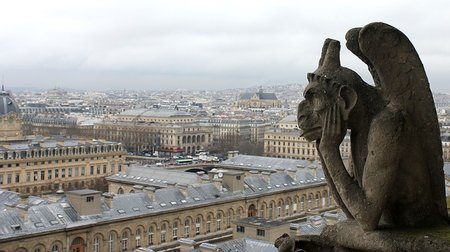
The Notre Dame that you see today is the product of many restorations and renovations ….much of which happened in the 19th century. The cathedral is a result of the history of architecture and the contributions of many rather than any one person’s vision.
The gargoyles that dominate Notre Dame postcards today were added in 19th century by the chief restorer Eugene Emmanuel. For example all 20 bells of the church were melted to manufacture cannons (apart from the iconic Emmanuel bell) and similar quality bells were restored only in 2013. Many restorations and renovations have changed the face of the cathedral but what has endured is the spirit of Christianity that it personifies.
Design and Important Elements
Rose Windows
The Notre Dame stained glass windows are very appealing and the 3 rose windows are particularly attractive. There are rose windows in the western, southern and northern façade. The south rose window is particularly beautiful and it was gifted to the cathedral by King Louis IX of Paris (known as Saint Louis). There is 12.9m of colorful glass which filters daylight and exposes the finesse of the architecture while the 33m high ceiling seems to rise up to the sky.
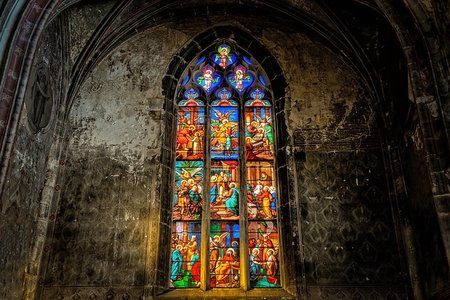
Bell Towers
There are 2 giant 13th century bell towers in the cathedral and tours will require visitors to climb up their 387 steps in order to have a look at Chimera gallery and gargoyles. There is stryge; the star amongst the gargoyles who looks all over Paris. The gargoyles had a practical function…they were rain spouts which divided the roof water and threw it outwards as far as possible from the church structure into lead gutters.
The towers are 69 meters high and till the completion of Eiffel Tower they were the highest structures in Paris. The north tower is accessed by visitors who use a stairway and stop at the Gothic Hall (right beside the rose window) to view the sculpture and painting selection from ancient cathedral history.
Bells
There are 10 bells right now in the cathedral and the biggest one is Emmanuel that dates back to 1681. The 13 tonne bell always rings first (5 second) before the others. Right now a newly forged and even bigger bell called Marie hangs with Emmanuel in south tower. The ringing of the Notre Dame bells is an important part of the cultural fabric of Paris.
West façade
The west portals (3 of them) of Notre dame are particularly interesting and all of them have sacred scene depiction. Examine one of them…The Portal Sainte Anne carefully and you will see a marked difference in style and décor. Just for trivia…this portal along with many other elements does not belong to the Notre Dame; they are parts of earlier roman cathedrals. The center door is called “last judgment portal” and the “portal of the virgin” lies to the north. Just beneath the balustrade there a gorgeous gallery of statues symbolizing the 28 kings of Judah.
Treasures of the cathedral
The audio tour and commercial tour includes a visit to the treasury which stands on the sacristy opening on the southern side of the choir. More than 13 million people come in Annually to see the sacred treasure; crown of thrones. Other important relics are holy nail and fragment of true cross.
Wooden Structure and Buttresses
The wooden timber frame of the cathedral is called the “forest”. Almost 52 acres of trees were demolished in the 12th century to create this woodwork. The exposed flying buttresses (a support element for the slim walls) may seem like a common Goth architecture element now but back when they were made…it was a revolutionary untried idea.
Church spire
The cathedral spire lies over the altar and transept and its lead with a heart of oak weighing 750 tonnes. The spire is flanked by copper statues of the 12 apostles in four groups….each group stands in one direction of the compass. The spire top contains a rooster and the birdhouses piece of crown of thorns and the bodies of saint Denis (patron saint of city)…these were secured inside in 1935 as a sort of protection for the church’s parish.
Church organ
The Notre Dame organ has nearly 8,000 pipes and can only be played with 5 keyboards. Most historians agree that this is the largest organ in France. Look closely and you will see vicious slashes on the organ loft… damages caused by the violent mob of French revolution.
Crypt
The archeological crypt was made in 1965 and it ensconced historical ruins that embody the earliest settlement of Paris right to modern day Paris. Musee Carnavalet manages the crypt which has a huge exhibit and lovely architectural models of separate time zones. There is under-floor heating that was installed in roman times.
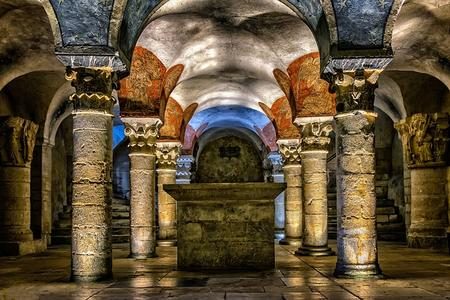
Beehive
Right on the sacristy is a smallish beehive that was purposely installed in 2013. Buckfast bees live here (the gentlest of all) and they make honey from pollen harvested from the nearby gardens. The honey is given away to the poor and needy according to church tradition.
Open Hours, Tours & Tickets
The Notre Dame cathedral is open from 7.45 a.m. to 6.45 pm everyday apart from Sundays when the closing time is 7.15 p.m. There is no admission fee.
A commercial tour is offered by Center des Monuments Nationaux that includes a round of the Notre Dame towers and the upper zones of west façade that date to 12th century along with a close look at the 19th century gargoyles. Climbing the south tower means climbing 387 steps without any help so be in top shape!! For availing the tour get in through rue du Cloister. For more information about group bookings and discounts call 01 53 10 07 01. The highlights of this tour are a look at the biggest bell of the cathedral (bourdon) and the view from the roof.
The archeological crypt under Notre Dame Paris square contains precious excavation remains that were found during 1965 by Old Paris commission. There are special tours for exploring this place aimed at people who want a deeper look at the history of the building. Carnavalet museum authorities offer a tour with limited access to the crypt. Call 01 55 42 50 10 to know more.
Prices of commercial tour range from 10 euros…
There are free hour long tours offered by the cathedral and they concentrate mostly on the spiritual message of the church along with an overview of the important architectural and artistic elements of the building. Hosts and hostesses are found at the reception desk…they happily answer queries and narrate history for free.
There are 35 minute audio guided tours along with a treasury visit that’s offered in multiple languages which allow participants to find their own route around the Notre Dame. Audio tours are available from 9.30 a.m. to 6.00 p.m. and cost 5 euros. Booklets are available at reception desk and sales counter (price ranges from 2 euros to 20 euros) and they contain cathedral history, photographs, interviews archived article readings etc.
You can book one of several guided tours of Notre Dame online through this Viator site.
For security reasons visitors cannot keep luggage inside the cathedral.
Location & How To Reach
The Notre Dame lies on Ile de la Cité (the lovelier of the two islands on the Seine river) in the antique center of Paris. It is flanked by Hotel Dieu and Police Prefecture; both of which are some meters away from Sainte Chapelle. The island was home to the royals and the church and still breathes history with the Conciergerie, Notre dame and Sainte Chapelle.
The island is connected to right and left banks of Seine by 8 bridges and by 1 bridge to Saint Louis. Port Neuf, Pont Saint Michel, Pont au Double can be used to access left bank while Pont au Change, Pont d’arcole and Pont Notre Dame can be used to access right bank. Touring the Ile de la Cite and Saint Louis should take away at least 3 to 4 hours of your time …these islands are royal time capsules with history living on their land.
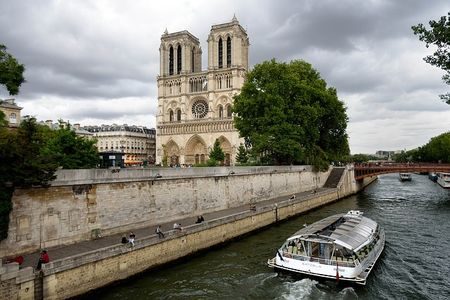
Here is how you can reach the Notre Dame:
The nearest RER station (line B & C) to the Notre Dame is the Saint Michael Notre Dame station.
The nearest metro stations from Notre Dame are Saint Michael (line 4), City Hall (line 1& 11) and Cluny La Sorbonne (line 10).
Many RATP bus routes go up to the Notre Dame and some of them are 21, 38, 85, 96 (these stop at Court of justice stop). Some routes like 21, 85, 98 and 38 stop at Saint Michel stop while lines 24 and 27 stop right in front of Notre Dame at Notre Dame stop.
Tourist buses run by “red cars” stop opposite Rue d’Arcole. The hop on hop off bus stop for Notre Dame is on rue de la Cite.
You can easily find taxis from the stands in Parvis Notre Dame, Place Saint Michel and Place Maubert. There is a large Op n Go car park right near the cathedral and you need to book your space in advance from Op n Go Website. Apart from this there is a car park in Place du Parvis Notre Dame and another in Boulevard du Palais (both walking distance from cathedral).
There are lots of interesting eateries and restaurants around like the Maoz vegetarian restaurant (8 rue Xavier Privas) near the cathedral. This is a quick takeaway place where you can grab amazing falafel and pita. Then there is Le Petit Chatelet (rue Bucherie) right beside Notre Dame Cathedral…it’s cozy and serves great French food.
Vegetarian restaurants like Le Grenier de Notre Dame (rue Bucherie) and fancy dinner places like Comme Chai Toi (Quai Montebello) are other options. For a great selection of wine and cheese head off to La Reserve de Quasimodo and for Japanese food Sola (rue de l’Hotel Colbert) is another great option.
Address
6 Notre Dame Square, Place Jean Paul II, Paris 75004
Phone: +33 142 345610 (call between 9am to 6pm), Notre Dame Website
Also Read
 A travel addict. Still celebrating the day when he quit his high-profile corporate job to pursue his passion for travel writing.
A travel addict. Still celebrating the day when he quit his high-profile corporate job to pursue his passion for travel writing.